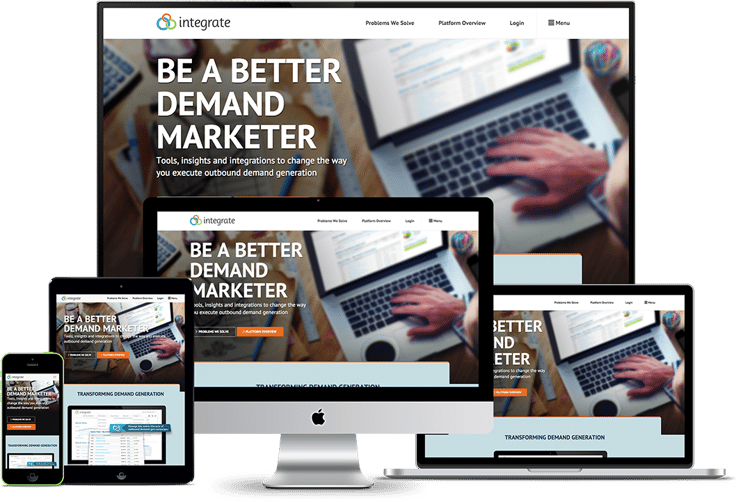
How an Inbound-Driven Website Redesign Increased Integrate's Conversion Rate by 271%
What do you do if you are a software company with an amazing product, but your message just isn't connecting with your potential customers as well as you would like? That's the problem Integrate was facing a few months ago, and that's where our story begins.
Integrate is a software platform for demand generation marketers. It helps them manage their outbound lead generation more effectively and connects outbound marketing programs with core marketing systems (like HubSpot). It's a brilliant piece of software for setting up and tracking outbound campaigns, managing creative assets and content across multiple channels, and identifying bad lead data, so you only have to spend on qualified contacts.
In a nutshell, this software completely transforms demand generation marketing and gives the marketer control of their various outbound campaigns. It brings accountability to publishers and media partners and provides the ability to scale working campaigns across multiple sources in a way that would be completely impossible with siloed information.
The platform is so useful, demand generation marketers should be flocking to Integrate's website and using their platform, and many were. But the marketing team at Integrate understood there was something missing that was holding their results back.
It was our job at Lean Labs to find out what that problem was and come up with a plan to fix it.
Identifying the Problem
The first time we loaded up Integrate's website, we were impressed. Most of the companies who approach us have glaring website design problems, but in Integrate's case, their website was actually very well designed. The problem was much harder to identify than a horrible website would be.
It's not that we're super-hero geniuses at Lean Labs and nailed the problem right away. The problem kind of tapped us on the shoulder and said, "here I am."
Our marketing guys kept asking, "what do they do, exactly?" Our designer kept asking, "what do they do." That's when we realized the problem was making itself evident - the website needs to answer that question quickly and definitively.
The problem wasn't the value of the platform, but it was in understanding how to communicate that value in a way visitors could quickly understand it, get it, and envision how it could make their lives better.
We set out with a plan to improve the message and user experience, and to turn their website from an online brochure into an intentional buying journey.
Our Metrics for Success
What gets measured gets improved, right Mr. Drucker? We agree.
We identified a few metrics that would signal if we had failed or succeeded in our mission:
- Click Through Rate
- Average Pages Per Visit
- Overall Conversion Rate
The Ultimate Question: Can we craft the site to facilitate the buying journey and get more leads flowing into the system?
Crafting the Buying Journey
Before we could get started with changing things on their site, we had to help Integrate (and ourselves) understand their business model from their customer's point of view. To do that, we went to one of our favorite tools: the Business Model Canvas.
This tool helps us to identify and focus on the customer's problems, segments, and likely alternatives so that we can discover the best way to position value. In this practice, we dove deeply into their buyer personas to understand their triggers, needs, motivations, and concerns. This helped all of us to get our finger on the pulse of the "thing" their customers wanted most.
The hardest part of this practice was understanding that Integrate works with different marketers in various roles, and making our message connect and help all of them understand the role Integrate could play in their marketing structure.
This is why this practice is such hard work: you can have as many personas, triggers, and benefits as you want, but you only have one home page. In order to communicate the value that matters, you have to boil all this data down into a Unique Value Proposition (UVP) that resonates with real people, who are influenced by all of these variables.
Enter our second favorite tool, the Value Proposition Map.
This tool helped us to really understand the needs, wants, feelings, and fears (objections) of Integrate's target personas. Then, we mapped them to features, benefits, feelings after using the platform, and answers to the objections.
Going through this practice helped us to get an idea of ways to communicate instant understanding of what Integrate is, what they do, and how they can help.
Identifying the Best UVP
Using the insights from these two practices, we ran intensive multivariate testing on different UVP's and calls to action on their current website. Through multiple tests, we were able to identify the UVP that resonated the most with their audience and drove the most engagement and higher meaningful click-through rates.
However, nailing the UVP wasn't the only thing that needed to be done. Understanding value instantly is not the same as understanding fit. So the buyer's journey was still in need of crafting.
Promoting the Information They Need
Now that we had the understanding of how to communicate the value of Integrate and the Unique Value Proposition in place, we had to craft the site flow. We had to change the user experience of the website into a buying journey as opposed to a simple online brochure.
This led to a minimized navigational structure that focused on just two things:
- The Problems They Solve
- How They Solve Them (Platform Overview)

We narrowed the navigation down to these two for very specific reasons:
- First, marketers have very specific jobs to be done, and they experience very specific problems as a result. If you can nail their problem well, customers will automatically assume you have the solution. Focus number one had to be the problems Integrate solves. We wanted to address these problems in such a way that their target personas would get the emotional feeling that Integrate understands their plight.
- Second, we focused on the platform overview, inviting users in without asking for a demo or a trial. We wanted them to understand the value of the platform, to walk through it in a threat-free environment to understand how Integrate's platform can help them, and put their finger on the benefits that mattered to them.
The language and experience were crafted intentionally. Rather than offering a "free trial" or "demo," we offered a "preview." Today, especially for savvy marketers (Integrate's target personas), demos and free trials are indefinitely tied to painful sales conversations.
We wanted to use language that would disarm the user, and give them a sales-free zone to explore the value of the platform without it being attached to a sales conversation.
In other words, we gave the users what they wanted, on their terms.
The Rest of the Story: The Results

Integrate was a pleasure to work with because they understood their website had to be more customer-centric. It had to focus on the customer's needs and be structured into a buying journey. Rather than dead-end pages, which most websites suffer from, Integrate.com now features a "next step" on every page, leading visitors to logical conversion points.
Since the site went live, results are off the charts!
Within 60 days of Launch:
- Organic Search Traffic Increased 33%
- Total Page Views Increased 198%
- Average Page Views Per Session Increased 43%
- Bounce Rate Decreased 65%
- Visits-To-Contact Conversion Rate Increased 271%
Regarding total leads generated, they have seen a 174% increase compared to the same period prior to launch. But before you pat us on the back, remember Integrate's team are savvy marketers.
Around the same time the new website launched, they published a collaborative eBook on account-based marketing with Matt Heinz, which generated a lot of buzz on its own. When you factor out the leads from that resource, the leads attributed just to the website is an increase of 45%.
It’s also interesting to note that by repositioning the core CTA from “Request a Demo” to “Preview Integrate,” the traffic to this page increased by 332%.
In short, more marketers are discovering the website. They’re spending more time consuming content, visiting more pages and getting more value from their journey.
While all of these numbers are impressive, at the end of the day, value sometimes goes beyond data. The biggest impact we’ve received from our work with Lean Labs is the fact that everyone who visits the website now, quickly gets what we do – whether a potential customer, an industry influencer, a media contact or an analyst. We’ve received countless kudos on the clarity of our messaging and the realness of our tone. We’ve learned to speak to our customers in everyday language as opposed to industry hyperbole. And it’s made all the difference in the world. We can’t thank the Lean Labs team enough for guiding this effort.
- Triniti Burton, Integrate
For before and after shots and more, view the case study.
Works hard to help organize funds and folks as the Head of Finance and Onboarding for Lean Labs. Earned 16 HubSpot certifications and 11 Digital Marketer certifications while reading over 30 marketing books in the last 4 years. Loving husband for 24 years and proud father of 5. Masquerades as Mr. Fix-it in his off hours because he appreciates quality tools and enjoys repairing broken stuff.
About Lean Labs
The only outsourced growth team with a track record of 10X growth for SaaS & Tech co's. 🚀
Explore Topics
Recent
Related
Popular
- CTA Best Practices: Crafting Calls-to-Action That Actually Convert
- The 5-Step Startup Marketing Strategy Fueling Massive Growth in 2024
- From Platform Problems to Performance Gains: HighByte's Website Evolution
- Clear, Clean, and Conversion-Ready: HubSearch's Journey to a Better Website
- 8 AI Marketing Tools Your Team Needs (+ How To Get The Best Results)

Discover the Hidden Strategies We Use to 10X Our Clients Growth in 36 Months!
The Growth Playbook is a FREE guide to planning, budgeting and accelerating your company’s growth.



